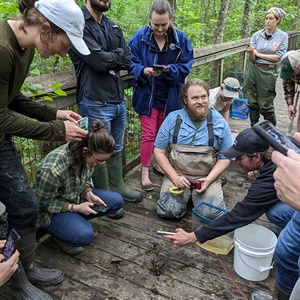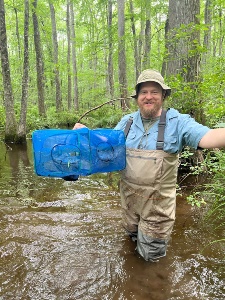 Last month, it was my pleasure to instruct a workshop on crayfish identification, field techniques, life history, and ecology sponsored by the Arkansas Chapter of the American Fisheries Society (AR-AFS). Student and professional members of AR-AFS, as well as staff from the Arkansas Natural Heritage Commission, spent the morning at the Department of Arkansas Heritage headquarters learning about the approximately 60 species of crayfish that call Arkansas home.
Last month, it was my pleasure to instruct a workshop on crayfish identification, field techniques, life history, and ecology sponsored by the Arkansas Chapter of the American Fisheries Society (AR-AFS). Student and professional members of AR-AFS, as well as staff from the Arkansas Natural Heritage Commission, spent the morning at the Department of Arkansas Heritage headquarters learning about the approximately 60 species of crayfish that call Arkansas home.In the afternoon, we traveled to Lorance Creek Natural Area (NA) where we pulled traps that were set the evening before in the swamp below the boardwalk. We found species such as Ouachita River Crayfish (Procambarus ouachitae), Red Swamp Crawfish (Procambarus clarkii), White River Crawfish (Procambarus acutus), and Devil Crayfish (Lacunicambarus diogenes). We also did a demo on techniques for excavation of burrowing crayfish, which resulted in finding another species, the Digger Crayfish (Creaserinus fodiens). Participants got a chance to get up close and personal with these fascinating animals in the beautiful environment of Lorance Creek, a groundwater-fed cypress-tupelo swamp that is home to a diverse aquatic flora and fauna. In the evening, the group convened for a social event at Rattlesnake Ridge NA.
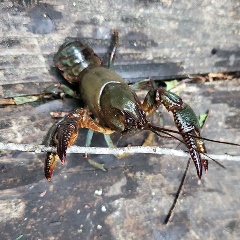 Arkansas is renowned for its biodiversity, but many may not think of crayfish as a particularly diverse group. Yet The Natural State is home to more species of crayfish than any other state west of the Mississippi River. Nearly every aquatic habitat in the state is home to some type of crayfish or another, from stream-dwelling species to swamp denizens to cave-adapted crayfish to primary burrowing species that are rarely seen above ground. Fourteen species are found only in Arkansas (endemic).
Arkansas is renowned for its biodiversity, but many may not think of crayfish as a particularly diverse group. Yet The Natural State is home to more species of crayfish than any other state west of the Mississippi River. Nearly every aquatic habitat in the state is home to some type of crayfish or another, from stream-dwelling species to swamp denizens to cave-adapted crayfish to primary burrowing species that are rarely seen above ground. Fourteen species are found only in Arkansas (endemic). At the workshop, participants learned to focus on anatomical features such as the shape
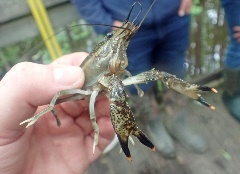 of the chelae (claws) and rostrum, i.e. the beaklike portion of the carapace between the eyes, when identifying crayfish. We discussed fascinating aspects of crayfish biology, such as their ability to regenerate lost limbs, how female crayfish carry eggs and young on their bodies, and the different sensory ways in which crayfish perceive their surroundings. An assortment of techniques for capturing and studying crayfish were covered, including kick-seining, stream-snorkeling, trapping, and excavation of burrows. We also covered issues related to conservation of crayfish, including potential threats posed by bait-bucket introductions and habitat alteration.
of the chelae (claws) and rostrum, i.e. the beaklike portion of the carapace between the eyes, when identifying crayfish. We discussed fascinating aspects of crayfish biology, such as their ability to regenerate lost limbs, how female crayfish carry eggs and young on their bodies, and the different sensory ways in which crayfish perceive their surroundings. An assortment of techniques for capturing and studying crayfish were covered, including kick-seining, stream-snorkeling, trapping, and excavation of burrows. We also covered issues related to conservation of crayfish, including potential threats posed by bait-bucket introductions and habitat alteration. 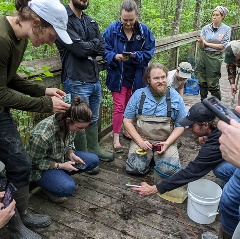 One of the most rewarding parts of my job is getting the opportunity to teach and provide outreach on topics that I care about. However, the success of this workshop was a group effort that would not have been possible without the support and assistance of friends and colleagues who are equally passionate about aquatic conservation in Arkansas.
One of the most rewarding parts of my job is getting the opportunity to teach and provide outreach on topics that I care about. However, the success of this workshop was a group effort that would not have been possible without the support and assistance of friends and colleagues who are equally passionate about aquatic conservation in Arkansas.Photos:
Photo 1 — Aquatic Ecologist Dustin Lynch with an aquatic trap full of crayfish at Lorance Creek Natural Area. Photo by ANHC staff.
Photo 2 — Devil Crayfish (Lacunicambarus diogenes) at Lorance Creek Natural Area. Photo by Dustin Lynch.
Photo 3 — Ouachita River Crayfish (Procambarus ouachitae) at Lorance Creek Natural Area. Photo by Dustin Lynch.
Photo 4 — Aquatic Ecologist Dustin Lynch shows workshop participants a variety of crayfish species collected in traps at Lorance Creek Natural Area. Photo by ANHC staff.
